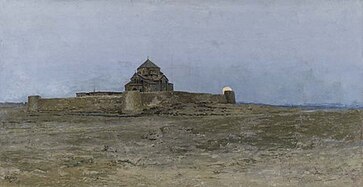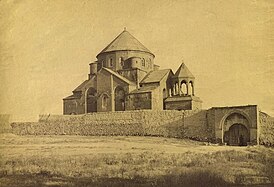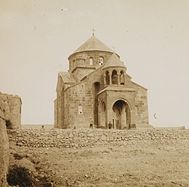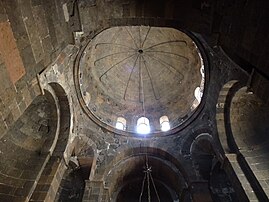Saint Hripsime Church
Saint Hripsime Church (Armenian: Սուրբ Հռիփսիմե եկեղեցի, Surb Hṙip‘simē yekeghetsi) is a seventh century Armenian Apostolic church in the city of Vagharshapat (Etchmiadzin), Armenia.
It is one of the oldest surviving churches in the country. The church was erected by Catholicos Komitas to replace the original mausoleum built by Catholicos Sahak the Great in 395 AD that contained the remains of the martyred Saint Hripsime to whom the church is dedicated. The current structure was completed in 618 AD. It is known for its fine Armenian-style architecture of the classical period, which has influenced many other Armenian churches since. It was listed as a UNESCO World Heritage Site along with other nearby churches, including Etchmiadzin Cathedral, Armenia's mother church, in 2000.
| Saint Hripsime Church | |
|---|---|
 An aerial view of the church, 2021 | |
| Religion | |
| Affiliation | Armenian Apostolic Church |
| Rite | Armenian |
| Status | Active |
| Location | |
| Location | Vagharshapat, Armavir Province, Armenia |
| Geographic coordinates | 40°10′01″N 44°18′35″E / 40.166992°N 44.309675°E |
| Architecture | |
| Type | Tetraconch |
| Style | Armenian |
| Founder | Komitas Aghtsetsi |
| Completed | c. 618 (church) 1653 (portico) 1790 (bell tower) |
| Specifications | |
| Length | 22.8 m (75 ft) |
| Width | 17.7 m (58 ft) |
| Dome height (inner) | 23 m (75 ft) |
| Official name: Cathedral and Churches of Echmiatsin and the Archaeological Site of Zvartnots | |
| Type | Cultural |
| Criteria | (ii) (iii) |
| Designated | 2000 (24th session) |
| Reference no. | 1011-004 |
| Region | Western Asia |
Background and foundation
According to the traditional account found in Agathangelos, Hripsime, a Roman virgin, and her companions (including Gayane), fled to Armenia to avoid persecution by the Roman emperor Diocletian. In Armenia, Hripsime was tortured and killed by king Tiridates III after she refused his attempts to woo her. After Tiridates's conversion to Christianity in the early fourth century (dated 301 or 314 AD), the king and Gregory the Illuminator built a martyrium at the location of her martyrdom as an act of remorse. It is, thus, one of the earliest Christian martyriums. It is believed to have been half buried underground, with an aboveground canopy structure.
Excavations inside the church during restoration works in 1958–59 unearthed black tuff fragments of an ornamented cornice under the supporting columns. They were immediately identified as having belonged to a pre-Christian Hellenistic structure, perhaps a temple, and quite similar in style to the cornice of the Garni Temple. It prompted scholars to believe that a pagan temple may have stood at the site or nearby. Additionally, the original steps descending to the underground crypt from before the altar were discovered.
The original martyrium was destroyed by Sasanian king Shapur II and his Armenian Zoroastrian ally Meruzhan Artsruni c. 363, along with Etchmiadzin Cathedral and other Christian sites. Catholicos Sahak (Isaac) built a (new) chapel-martyrium in 395, which later historian Sebeos described as "too low and dark". Archaeological excavations in 1976–78, led by Raffi Torosyan and Babken Arakelyan, uncovered the foundations of a small single-nave (basilica) church building around 10 m (33 ft) east of the current church, which is likely the remains of the late fourth century structure. Notably, Christian-style burials were also unearthed, which both scholars and the Armenian Church identified as Hripsime and her companions.
Seventh century historian Sebeos recounts that Catholicos Komitas (r. 615–628) destroyed the small martyrium and built the current church in the 28th year of the reign of Sassanian king Khosrow II (r. 590–628), which has been calculated as 618. This dating has been widely accepted. Two inscriptions record his role in its construction. Some scholars believe Komitas, also a hymnographer, may have been the architect of the church.
Inscriptions

The church contains two engraved inscriptions in the erkat‘agir uncial script recording the role of Catholicos Komitas in the construction of the church. The inscriptions contain no dates. The first has been conventionally dated to 618. Aleksandr Manucharyan suggested, based on its content, that the second was inscribed after the death of Komitas in 628. Greenwood proposed a dating between 616/617 and 628 for both. They are thus the second earliest extant Armenian inscriptions, behind the late fifth century inscription of the now-destroyed Tekor Church (dated c. 478–490).
The first inscription, four lines long, is located in the central part of the exterior surface of the western wall, and measures 202 cm × 60 cm (80 in × 24 in). The porch and the bell tower, added on its western side in the 17th and 18th centuries, effectively conceal it. Though previously photographed, it is not easily visible, and a researcher noted as recently as 2018, that its exact location is not known. It records Komitas's personal responsibility for the construction. It reads:
| ԵՍ ԿՈՄԻՏԱՍ ԵԿԵՂԵՑԱՊԱՆ ՍՐ ԲՈՅ ՀՌԻ{Ւ}ՓՍԻՄԷԻ ԿՈՉԵՑԱՅ ՅԱ ԹՈՌ ՍՐԲՈՅՆ ԳՐԷԳՈՐԻ ՇԻՆԵՑԻ ԶՏԱՃԱՐ ՍՐԲՈՑ ՎԿԱՅԻՑՍ Ք[ՐԻՍՏՈՍ]Ի | "I Komitas sacristan of saint Hṙi{w}p‘simē was summoned to the throne of saint Grēgor. I built the temple of these holy martyrs of Christ" ⠀ |
The second inscription, in three lines and measuring 150 cm × 35 cm (59 in × 14 in), is on the interior surface of the eastern apse, behind the altar. It was revealed under plaster during restoration works in 1898, when it was lightly damaged. It was likely originally placed on the northern apse and transferred to the eastern ape, an unusual location, when the former was dilapidated. It implores Christ to recognize Komitas's labors. It reads:
| Ք[ՐԻՍՏՈ]Ս Ա[ՍՏՈՒԱ]Ծ ՅԻՇԵԱ ԶԿՈՄԻՏԱՍ ՀԱՅՈՑ ԿԱԹՈՂԻԿՍ ՇԻՆ ԱՒՂ ՍՐԲՈՅ ՀՌԻՓՍԻՄԵԻ | "Christ God, remember Komitas kat‘ołikos of Armenia, the builder of saint Hṙip‘simē" ⠀ |
17th and 18th centuries
Not much in known about the church's history in the medieval period, but inscriptions indicate that it was intermittently active. In particular, an inscription from 1296 records that the release of the monastery from tithe and other taxes on cotton by local rulers. Another inscription, from 1302, on the lintel of the western entrance records the donation of 1,000 silver coins.

Arakel of Tabriz, a contemporary, recounted the state of the church in the early 17th century and provided details of its restoration (along with St. Gayane) by Catholicos Pilipos (r. 1633–1655). Following the deportation of Armenians to Iran by Shah Abbas in 1604–05, it was "without inhabitants and fences". Abandoned and defenseless, the church was also heavily dilapidated by that time. During periods of neglect, neatly cut facing stones were quarried from the church. Arakel recounts that it had no doors, no altar, the roof and walls had crumbled, and the foundations were shaken and dug up, while the interior was full of manure as livestock were driven into the church. The restoration of Hripsime under Catholicos Pilipos "took three years, from start to finish, for the work began in the [Armenian] year 1100 (1651) and was finished in the year 1102 (1653) with great expenditures and tremendous labor." This restoration encompassed the pediments, the roof of the dome, and saw the construction of a porch/portico or an open narthex (gavit) in front of the western entrance (upon which a bell tower was added in 1790).

Since its restoration in 1653, the church has regularly had a congregation. Subsequent Catholicoi, Eghiazar (r. 1681–1691) and Nahapet (r. 1691–1705), further contributed to its revitalization by adding buildings and supporting manuscript production. Six inscriptions, from the 1720s, engraved on its walls record the donations of salt, oil, incense, rice, candles, wine. An inscription by Aleksandr vardapet, who is most likely the later Catholicos Aleksandr II (r. 1753–55), records the donation of fifty sheep as breeding stock. In the 17th and 18th centuries, monks at St. Hripsime were provided bread and clothing from the monastery of Echmiadzin, but the monastery also possessed its own farmland and livestock. There is also an encrypted epigraph from 1721/22, left by future Catholicos Hakob V of Shamakhi (r. 1759–1763), is located on the left niche of the eastern façade.
Catholicos Simeon I of Yerevan (r. 1763–1780) raised a new cross on its dome in 1765 Simeon, and fortified the monastery in 1776 with a cob perimeter wall with corner towers, along with an arched entrance built in stone from the northern side. In 1790 Catholicos Ghukas Karnetsi (r. 1780–1799) added a rotunda-shaped bell tower on the porch/narthex built by Pilipos in 1653.
19th century and beyond

In 1894–95, under Catholicos Mkrtich Khrimian (r. 1893–1907), a two-story residence was built for the monks inside the monastery walls and the cob walls were replaced with that of stone in the eastern and southern sections. The church itself underwent considerable renovation in 1898.
In 1936, during the Soviet period, the church's foundations were strengthened and its roof, dome, the monastery walls and buildings were restored and the surrounding area underwent beautification.
Extensive restoration works and archaeological excavations were carried out at the church in the first years of the reign of Catholicos Vazgen I (r. 1955–1994), concurrently with Etchmiadzin Cathedral. The restoration works were overseen by Mikayel Mazmanyan, Varazdat Harutyunyan, Rafayel Israyelyan, Konstantine Hovhannisyan, Karo Ghafadaryan. Initially, its surrounding was beautified; its immediate surrounding was paved with tuff blocks, the steps leading to that area were renovated, and a decorated drinking fountain, designed by Rafayel Israyelian, was built in the yard.
Restoration works then moved to the interior, where the removal of white plaster from its walls began in May 1958. Traces of limewater were removed through sandblasting. The interior return it to its original appearance of dark grey-brown tuff color. The damaged stones were further replaced. A new altarpiece and chandelier was designed by Rafayel Israyelian, with the former containing a painting of the Virgin Mary by Hovhannes Minasyan. The restoration, started in 1955, was officially completed by 1962. The removal of the plasterwork furthermore revealed a system of 8 large and 16 small squinches under the circular drum.
The church underwent additional restoration in 1985, which was funded by Mari Hyusisian-Mndigian. The bell tower was restored in 1986–87 by Artsrun Galikyan and Avetik Teknetchyan. Galikyan also designed new wooden doors for the church.
Excavations in 1959 revealed the original floor around 40 cm (16 in) beneath the contemporary flooring surface, and, consequently, the floor was lowered.
Burials
Catholicos Komitas was presumably buried inside the church. A stone slab before the altar may be his tombstone. Catholicos Pilipos, who restored the church in 1653, was buried in the northern apse inside the church after refusal by the Iranian ruler of Erivan to permit his burial at Etchmiadzin. His marble tombstone was erected by Catholicos Yeprem I in the early 1800s. During restoration works in 1958–59, two graves were found in front of the western entrance, where, according to historical accounts, two Catholicoi were buried: Astvatsatur (r. 1715–1725) and Karapet II (r. 1726–1729). Their tombstones had disappeared in the early 1800s, and new marble ones were erected during the 1950s restoration. To the east of the church, a cemetery survives with around 50 tombstones, including 30 with inscriptions, dating to the 17th to 19th centuries. The perimeter wall, built in the 1890s, divides it into two. One notable burial is vardapet Stepanos Lehatsi (d. 1689), a member of the Etchmiadzin brotherhood.
Architecture
St. Hripsime Church is a domed tetraconch enclosed in a rectangle, with two angular niches on the northern and southern side. German art historian Wilhelm Lübke wrote that the church is built on "a most complicated variation of the cruciform ground-plan."
- Reception
Rouben Paul Adalian wrote that along with Saint Gayane Church, it stands as a "model of the austere beauty of early Armenian ecclesiastical architecture." Harold Buxton suggested that it is the most "perfect specimen of the best age of Armenian architecture." Frank Ching, Mark Jarzombek and Vikramaditya Prakash praised its "well-formed proportions and meticulous stonework". Howard L. Parsons called it "robust and finely proportioned" and described its style as "post-Romanesque". Its monumental exterior is "considered one of the great achievements of medieval Armenian architecture."
Imitations
The church is not the earliest example of this architectural form, however, the form is widely known in architectural history as the "Hripsime-type" since the church is the best-known example of the form. It has also been variously named "Jvari-type" or "Jvari-Hripsime-type" for Jvari in Georgia. Despite this, these words can be refuted by the fact that at the end of the 6th century an Armenian church was built in Avan with the same style as Jvari and St. Hripsime Church.
Notable churches with similar plans include the Surb Hovhannes (Saint John) Church of Avan (6th century), Surb Gevorg (Saint George) Church of Garnahovit (6th century), Church of the Holy Cross at Soradir (6th century), Targmanchats monastery of Aygeshat (7th century), Holy Cross Cathedral of Aghtamar (10th century), and Surb Astvatsatsin (Holy Mother of God) Church at Varagavank (11th century). The architectural form is also found in neighboring Georgia, where examples include the Ateni Sioni Church (7th century), Jvari monastery (7th century), and Martvili Monastery (10th century).
Modern
Its architecture has been directly replicated or inspired several churches in the modern period, especially in the Armenian diaspora. Notable examples include:
- St Hripsime Church in Yalta, Crimea (1917)
- St. Vartan Armenian Cathedral in Manhattan, New York (1968)
- St. Sarkis Armenian Church in Carrollton, Texas (2022)
Artistic and historic depictions
Hercule Nicolet https://grafika.ru/item/03-002167?k=8034
- It appeared as the frontispiece of Adrian Fortescue's 1913 book The Lesser Eastern Churches.
- The 20th-century floor mosaic created by the Israeli artist Hava Yofe inside the Chapel of Saint Helena at Jerusalem's Church of the Holy Sepulchre depicts the church along with other major Armenian sites. It also appeared on the cover of Robert W. Thomson's 1987 translation of Sebeos's history.
- It appeared on a 1988 Soviet stamp, and Armenian stamps in 2000, 2009, and 2018.
- It appeared on the 200 Armenian dram banknotes (in circulation from 1993 to 2004)
- A relief of the church is sculpted on the headquarters of the Eastern Diocese of the Armenian Church of America next to the St. Vartan Cathedral in Manhattan, New York
- A small-scale model of the church is displayed at the American Museum of Natural History in New York
- Paintings
- Grigory Gagarin, 1847
- Painting of the church by Vardges Sureniants, 1897
- by Yeghishe Tadevosyan, 1913
- Historic images
- The church on a 1691 map by Ottoman Armenian traveler Eremya Çelebi.
- from Ghevont Alishan's 1890 book Ayrarat
- c. 1900
- From H. F. B. Lynch's 1901 book on Armenia
- a 1911 photo reproduced in Strzygowski's 1918 book
- by Fridtjof Nansen, 1925
Gallery
See also
References
- Notes
- Citations
Bibliography
- Academic articles
- Harutyunyan, Varazdat (1984). "Պատմություն Ս. Էջմիածնի Մայր Աթոռի շինարարական գործունեության Ամենայն Հայոց Կաթողիկոս Վազգեն Առաջինի գահակալության օրոք (1956-1980). Վերանորոգման և բարեփոխման աշխատանքներ Ս. Հռիփսիմեի եկեցեցու". Etchmiadzin (in Armenian): 32–38. Archived from the original on 28 February 2024.
- Greenwood, Timothy (2004). "A Corpus of Early Medieval Armenian Inscriptions". Dumbarton Oaks Papers. 58: 27–91. doi:10.2307/3591380. ISSN 0070-7546. JSTOR 3591380.
- Maranci, Christina (1998). Medieval Armenian Architecture in historiography: Josef Strygowski and His Legacy (PhD thesis). Princeton University. OCLC 40827094.
- Published books
- Adalian, Rouben Paul (2010). Historical Dictionary of Armenia. Lanham, Maryland: Scarecrow Press. ISBN 978-0-8108-7450-3.
- Strzygowski, Josef (1918). Die Baukunst der Armenier und Europa [The Architecture of the Armenians and of Europe] Volume I (in German). Vienna: Kunstverlag Anton Schroll & Co. pp. 92–94.
- Neale, John Mason (1850). A History of the Holy Eastern Church. Part I. London: Joseph Masters.
- Ching, Frank D. K.; Jarzombek, Mark; Prakash, Vikramaditya (2017). A Global History of Architecture (3rd ed.). John Wiley & Sons. ISBN 9781118981337.
- Harutyunyan, Arsen [in Armenian] (2018). Ս. Հռիփսիմե վանքը [S. Hripsime Monastery] (PDF) (in Armenian). Mother See of Holy Etchmiadzin. ISBN 978-9939-59-213-8. Archived from the original (PDF) on 4 June 2020.
- Arakel of Tabriz (2010) [1662]. Book of History. Translated by George Bournoutian. Costa Mesa, California: Mazda Publishers. ISBN 978-1-56859-172-8.
External links

This article uses material from the Wikipedia English article Saint Hripsime Church, which is released under the Creative Commons Attribution-ShareAlike 3.0 license ("CC BY-SA 3.0"); additional terms may apply (view authors). Content is available under CC BY-SA 4.0 unless otherwise noted. Images, videos and audio are available under their respective licenses.
®Wikipedia is a registered trademark of the Wiki Foundation, Inc. Wiki English (DUHOCTRUNGQUOC.VN) is an independent company and has no affiliation with Wiki Foundation.



















